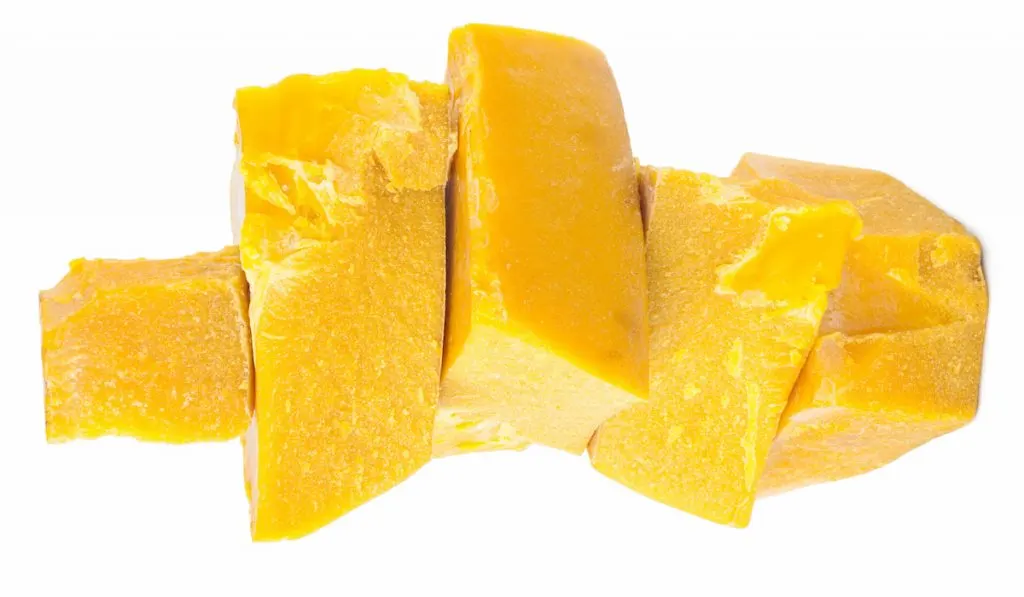*This post may have affiliate links, which means I may receive commissions if you choose to purchase through links I provide (at no extra cost to you). As an Amazon Associate I earn from qualifying purchases. Please read my disclaimer for additional details..
Flammable items are materials that easily ignite when exposed to fire or elevated temperatures in air. When you think of such materials, you think of gasoline, paper, alcohol, foil, and fiberboard.
Going by the definition above, you might wonder if beeswax fits the description. Well, let us see.
Is beeswax flammable?
Well, it turns out beeswax is not flammable.
Beeswax has a flashpoint of around 400°F. According to the guidelines of the National Fire Protection Association (NFPA), this is not flammable.
However, it qualifies as class IIIB combustible material. (source)
In this article, we discuss more on the reaction of beeswax and beeswax products to fire.
Table of Contents
Is Beeswax Flammable?
When an item burns in air, it is termed combustible. But based on the ease with which that item ignites, it may also be termed flammable.
In other words, all flammable items are combustible. But not all combustible items are flammable.
A flammable item will go up in flames at the slightest exposure to fire. Such items also have significantly low flashpoints. But beeswax does not fit this description.
The flashpoint of beeswax is around 400°F, a temperature too high to be flammable.
So, beeswax is not flammable. But is it combustible? Yes, it is. Raise the temperature to its flashpoint, and beeswax will burn in air.

Does Beeswax Burn?
Yes, beeswax burns. As already mentioned, it is combustible. If you raise the temperature of beeswax to its flashpoint, it will ignite and burn.
The duration for which beeswax burns is one of the reasons it is favored over paraffin candles. You can expect beeswax candles to burn two times longer than paraffin candles of the same size.
How Long Does Beeswax Burn?
How long beeswax burns depends on its volume. Of course, the larger the volume of the candle, the longer it will burn.
An 18 square inch (3 x 6”) beeswax pillar candle is expected to burn for as long as 110 hours. Going by that value, 1 square inch of beeswax candle should burn for 6 hours.
You should note, however, that factors may also affect how long beeswax burns. Some of such factors are the thickness and type of wick used in the candle.

Is Burning Wax Toxic?
Most types of wax are non-toxic when burnt. They would just undergo normal combustion and produce carbon dioxide and water.
But paraffin wax is thought to produce some other byproducts that may be harmful.
There are some controversies over whether burning paraffin wax is actually toxic.
But some studies suggest that while paraffin wax might release some toxic substances when burnt, the concentrations of the said substances are minimal.
In essence, unless one is exposed to burning paraffin wax for too long, one may not suffer any toxicity from it.
Whether scented or not, most wax should not be toxic under normal circumstances. But things might be different if one has an existing respiratory illness.
People with respiratory diseases might be affected by the fragrance of a burning scented candle.
So, although burning may not be toxic, people with asthma, hay fever, or similar illnesses should be cautious. Especially when the wax is scented.

Is Beeswax Toxic?
Beeswax is widely regarded as being non-toxic. Unlike paraffin wax, which is made from a mixture of petroleum compounds, beeswax does not produce toxic byproducts when burnt.
Beeswax is all-natural and follows the expected combustion process.
Besides, beeswax is naturally scented. It has a mild honey-like fragrance, which should be safe for people with respiratory diseases under normal circumstances.
So, people with asthma or hay fever may find the fragrance of beeswax less triggering than scented candles.
The conclusions above apply to 100% beeswax. Sometimes, beeswax is mixed with other types of wax to alter its properties. In such cases, the conclusions above may not apply.
While beeswax may not be toxic when burnt, it may be harmful when swallowed. If a person swallows large quantities of beeswax, they may experience an intestinal blockage.
When this happens, making the person throw up is not an option. Instead, call emergency services and let them tell you what to do.
Do Beeswax Candles Burn Clean?
Under the right conditions, beeswax candles will burn clean.
So, what are the right conditions for beeswax candles to burn clean? For one, keep the wick trimmed and keep the candle away from windy areas.
More importantly, do not place the candle in an oxygen-deficient space. The lack of oxygen promotes incomplete combustion, which in turn leads to the production of soot.
One advantage beeswax candles have over other types of candles is that they burn at higher temperatures. So they may produce relatively less soot.

Is Beeswax Polish Flammable?
Beeswax polish might be flammable. It all depends on the ingredients used in making it.
The solvents used in preparing beeswax polish are the likeliest to cause flammability. Liquids like turpentine and mineral spirits are usually used as solvents in beeswax polish.
Alone, these substances are flammable, and when incorporated into the polish, they may retain their flammability. Therefore, it is better to treat beeswax polish as flammable if it contains a flammable ingredient.
Final Take
Alone, beeswax is not flammable. Flammable materials are substances that ignite below 100°F, but beeswax will not ignite until you get it to 400°F.
However, when beeswax is mixed with a flammable material, the resulting mixture may be flammable.
Resources
- https://www.sciencedirect.com/topics/materials-science/flammable-material
- https://ehs.princeton.edu/book/export/html/195
- https://www.beehivecandles.com/help/beeswax-vs-paraffin
- https://www.housebeautiful.com/lifestyle/a25656783/candles-bad-for-you/
- https://www.shape.com/lifestyle/mind-and-body/are-candles-bad-for-you
- https://www.purplespinelsoaps.com/single-post/2017/09/08/benefits-of-100-pure-beeswax-candles
- https://medlineplus.gov/ency/article/002760.htm#
- https://millbee.com/blogs/blog-and-events/7-reasons-you-should-switch-to-beeswax-candles
- https://www.instructables.com/DIY-Making-Beeswax-Polish-for-Furniture/
- https://cambridgetraditionalproducts.co.uk/blog/turpentine-versus-white-spirit-in-beeswax-furniture-polish
- http://www.pysanky.info/Chemistry/Beeswax.html
- https://fscimage.fishersci.com/msds/02556.htm
